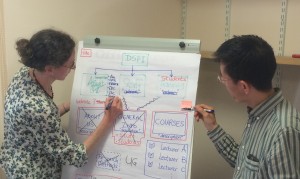Since Spring 2015 the WISE project has been working with 19 departments, faculties and doctoral training centres to develop and improve their WebLearn presence. In these collaborations we’ve been facing a perennial problem for learning technologists: namely, how to achieve buy-in from academics and students. We’ve had a good measure of success to date, and so here are nine practical tips which summarise what we have learned so far from engaging with our participants. We hope you’ll find them useful too.
1. Know which people to target first
![]() We’ve found that course sites in WebLearn tend to be designed and managed by administrators in a ‘gatekeeper’ role, rather than by academics.
We’ve found that course sites in WebLearn tend to be designed and managed by administrators in a ‘gatekeeper’ role, rather than by academics.
- Start by building a productive relationship with the administrators: listen to their concerns and understand their preferred way of working. Once you’ve established that relationship, they’ll feel comfortable about introducing interested academics to work with you. Other academics will come on board once they see what their peers are doing with WebLearn – and the benefits that it can bring.
2. Ask people how we can best engage with them
![]() As learning technologists, we may think we know how best to introduce WebLearn to academics and administrators. But do we? This is some of the advice we received during a conversation with a group of participants in the WISE project:
As learning technologists, we may think we know how best to introduce WebLearn to academics and administrators. But do we? This is some of the advice we received during a conversation with a group of participants in the WISE project:
- Provide a ‘hook’ to attract and inspire staff: ie a ‘template’ site that gives them ideas for how their own site might look.
- ‘Concentrate on individual needs and preferences; show each academic how they can use WebLearn to address these successfully.
- Harmonise the work of the WebLearn learning technologists with the academic development programmes offered by the Oxford Learning Institute.
3. Take the training to staff and students: don’t leave them to take the initiative
![]() It’s difficult to attract academics to come to WebLearn training courses that are held in a central location (the IT Services Department). Also, even though there is plenty of online help in WebLearn, many students – as well as staff – remain unaware of some of its handy features eg how to customise the ‘My Sites’ list.
It’s difficult to attract academics to come to WebLearn training courses that are held in a central location (the IT Services Department). Also, even though there is plenty of online help in WebLearn, many students – as well as staff – remain unaware of some of its handy features eg how to customise the ‘My Sites’ list.
- Arrange (with administrators) to give a brief introductory talk on WebLearn at faculty or departmental meetings where academics are present.
- Provide WebLearn courses for staff, as well as inductions for students, locally in the faculty or department.
- Since incoming students are often overwhelmed by ‘just-in-case’ information from all sources, supplement their WebLearn induction with opportunities for ‘just-in-time’ personal support throughout the year.
4. Make the training relevant
![]() One size doesn’t fit all! We have found that departments differ, not only in the disciplines taught, but also in their approach to technology-enhanced learning and teaching.
One size doesn’t fit all! We have found that departments differ, not only in the disciplines taught, but also in their approach to technology-enhanced learning and teaching.
- Running WebLearn courses locally means that you can customise their format and content to the specific pedagogic and technological needs and preferences of the faculty or department, and to the roles played by specific individuals.
- Allow plenty of discussion and hands-on practice.
- Provide content with which participants on the training course can identify even if it isn’t directly related to the discipline that they teach.
- Don’t overwhelm your audience by telling them about all of WebLearn’s tools and features at once. Focus at first on the basics so that staff can become productive quickly; then propose more advanced courses once staff feel confident.
5. Support safe experimentation
![]() Users want to try out new tools and approaches, but often tell us that they are concerned about ‘messing up’ a live site or ‘breaking’ the technology.
Users want to try out new tools and approaches, but often tell us that they are concerned about ‘messing up’ a live site or ‘breaking’ the technology.
- Offer to create a ‘playpen’ (or ‘sandpit’) for an individual department, course or member of staff. This is a separate site for them to experiment with different tools and techniques, without compromising current teaching and learning activities or content.
6. Keep in touch with your existing users while nurturing new ones
![]() Where resources for supporting users are limited, it can be hard to strike a balance between getting new WebLearn users up and running, and ensuring that established users remain happy and engaged.
Where resources for supporting users are limited, it can be hard to strike a balance between getting new WebLearn users up and running, and ensuring that established users remain happy and engaged.
- Maintain regular contact with all your WebLearn users: eg through a mailing list, blog and/or Twitter. This will ensure that everyone receives news of technical developments, ideas for different techniques etc.
- Create opportunities for new and established users to learn from each others’ experiences: eg through a face-to-face user group (see ‘Further information’ below) or an online mailing list.
- Capitalise on award schemes for innovative teaching, both within the institution and beyond. Supporting your WebLearn users to apply for such awards could result in professional recognition for them on a wider – maybe national or international – stage (see ‘Further information’ below).
7. Establish WebLearn ‘champions’
![]() Academics are often keen to introduce new technologies into their teaching, but they don’t know where to look for guidance. Furthermore, our research shows they may respond more positively to advice from a fellow academic who has tried something successfully.
Academics are often keen to introduce new technologies into their teaching, but they don’t know where to look for guidance. Furthermore, our research shows they may respond more positively to advice from a fellow academic who has tried something successfully.
- Harness the enthusiasm and drive of experienced WebLearn users and encourage them to become champions of the VLE: proselytisers, influencers and even mentors to their colleagues.
8. Get a student’s-eye view of WebLearn
![]() In focusing on the needs of those who use WebLearn in their teaching, it can be easy to overlook the students experience of learning in the VLE.
In focusing on the needs of those who use WebLearn in their teaching, it can be easy to overlook the students experience of learning in the VLE.
- Organise focus groups with students to gather feedback on WebLearn and to find out what they want.
- Hold ‘walk-through’ sessions with individual students in order to understand in more detail how they use WebLearn and to identify any sticking-points.
- Be a fly on the wall: if possible, attend lectures to see how a particular course is taught. Being an observer could give you valuable insights into how the lecturer might enhance, complement or supplement their face-to-face delivery with WebLearn tools (or, indeed, with other digital technologies).
- If opportunities for direct contact with students are limited, seek out the experience of others in the learning technology community. For example, post enquiries on discussion forums or mailing lists, or look up reports of relevant research.
9. Above all, be a good listener
![]() Learning technologists, teaching staff, administrators and students all come to WebLearn from different starting points. We have, at best, an incomplete knowledge of the perspective of another party, and we will often use different terms for the same thing. As a result, there’s a risk that we may misinterpret each other’s needs and wishes.
Learning technologists, teaching staff, administrators and students all come to WebLearn from different starting points. We have, at best, an incomplete knowledge of the perspective of another party, and we will often use different terms for the same thing. As a result, there’s a risk that we may misinterpret each other’s needs and wishes.
- Make sure you are familiar with the University’s way of working: eg its devolved model of decision-making.
- Make sure you are thoroughly versed in the faculty or department’s approach to teaching and learning.
- Listen carefully to what the staff and students tell you; frame your response to them in relation to the situation they describe, rather than leap in immediately with a WebLearn solution.
- As suggested in tip 8, observe teaching staff in action with their students.
Further information
WebLearn user group site (Oxford users only)
Blog posts featuring WebLearn users in awards for excellence in teaching:
- WebLearn in the limelight at the University teaching awards 2015
- WebLearn user Dr Lucy Tallents wins 2015 Teaching With Sakai Innovation Award
 This post was authored by Fawei Geng with assistance from Liz Masterman. We thank the following WISE project team members and project participants for their contributions: Steve Burholt, Jill Fresen, Xavier Laurent, Elizabeth Jeffers, Anna Pleshakova, Lucy Tallents and Daniel Waters.
This post was authored by Fawei Geng with assistance from Liz Masterman. We thank the following WISE project team members and project participants for their contributions: Steve Burholt, Jill Fresen, Xavier Laurent, Elizabeth Jeffers, Anna Pleshakova, Lucy Tallents and Daniel Waters.
The ‘i’ icon used above is licensed CC BY Aha-Soft Team and was retrieved from Iconfinder.
